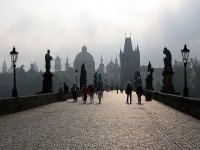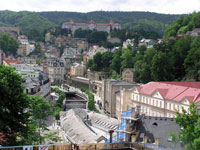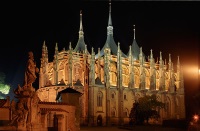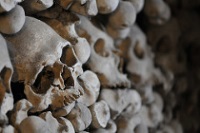Country guides

Things to do in Czech Republic
Sightseers in the Czech Republic will enjoy the very best of classical Europe, as well as a country bursting with charm. Most visitors spend their time almost exclusively in Prague, enjoying the beauty of the medieval buildings and evocative scenery of the river-front location, while sampling the cultural delights of the dynamic live music and theatre scenes. Attractions in this beautiful city include Charles Bridge (the most photographed feature of the city), the Old Town Square, St Vitus Cathedral and numerous incredible buildings in the Castle District on the hill above Prague.
Visitors shouldn't neglect the host of delights outside of Prague, though. These include world-class attractions such as picturesque Cesky Krumlov, the fascinating Ossuary of Kutna Hora, and Karlsbad Vary: the pride of the Czech Republic's many spa resort towns. The country also boasts some wonderful hiking trails and scenic areas, making it the ideal destination for adventurers. The countryside is dotted with numerous castles, keeps and medieval villages.
The most popular time to visit is over the peak summer months of July and August, although Prague in particular can get very crowded. Spring has mild weather and warm days and is an ideal time to visit.

The Castle District
Most travellers will agree that a visit to Prague Castle is essential during any holiday in the Czech Republic. Located in the city's Hradcany neighborhood and dating from the late…
The Castle District
Most travellers will agree that a visit to Prague Castle is essential during any holiday in the Czech Republic. Located in the city's Hradcany neighborhood and dating from the late ninth century, Prague Castle has been central to Eastern European history for centuries, housing Holy Roman Emperors, the Habsburgs, Bohemian kings and, more recently, the Czech Republic's President. It is the largest castle in the world in terms of area, and it has undergone many dramatic changes in architectural style over the course of its 1,000-year history. Visitors will see the various aesthetics on numerous buildings constructed within its walls.
The Castle District surrounds Prague Castle and stretches across the top of the hill. Overlooking the city and incorporating Prague's best churches and museums, it is set around immaculate gardens, fortifications, state apartments and three courtyards, with the dominant feature, St Vitus Cathedral, occupying most of the third courtyard. Other highlights include St. George's Basilica, the Benedictine Convent (which holds the National Gallery's remarkable collection of old Bohemian art), the Powder Tower (one of the original city gates), and the Golden Lane with its medieval workshops.
Travellers can also visit the Old Royal Palace, which was home to the Kings of Bohemia from the 11th to the 17th centuries. It contains the Royal Apartments and Vladislav Hall, where kings were crowned and presidents are still sworn into office. English language guided tours and audio-guides are available; visitors can watch the Changing of the Guard on the hour, with the fanfare and flag ceremony included at noon.
Website www.hrad.cz/en/prague-castle-for-visitors

Charles Bridge (Karluv Most)
Visitors to Prague enjoy photographing The Charles Bridge more than any other feature in the city. Built to replace the Judith Bridge (which had been washed away by floods in 1342)…
Charles Bridge (Karluv Most)
Visitors to Prague enjoy photographing The Charles Bridge more than any other feature in the city. Built to replace the Judith Bridge (which had been washed away by floods in 1342), its construction began in 1357 and concluded in the 15th Century. Up until 1841, it was the only bridge in Prague and the only means of crossing the Vltava River. The Charles was closed to traffic in 1978 and has been a pedestrian bridge ever since.
The bridge's 30 statues of saints were originally erected between 1683 and 1714, and create a unique combination of Baroque and Gothic styles. A festive crowd usually strolls across during the day, with throngs of people picking their way through the happy mix of buskers and artists. The bridge is far quieter at night, though, when the crowds have left and only the statues stand guard. Under moonlight, the setting presents some beautiful photo opportunities.

Old Town Square
Prague's Old Town Square has been the heart of the old city since the 11th century and still hosts a variety of markets, such as the whimsical annual Christmas markets. An odd Art …
Old Town Square
Prague's Old Town Square has been the heart of the old city since the 11th century and still hosts a variety of markets, such as the whimsical annual Christmas markets. An odd Art Nouveau monument to the religious reformer, Jan Hus, stands at its centre, while the Old Town Hall features Prague's ornate, Gothic Astronomical Clock. The clock shows three different times and draws throngs of people on the hour, who gather to watch the brief mechanical performance of apostles, Christ, a skeleton and a rooster. Tourists can climb the tower for a behind-the-scenes look at the mechanics of this beautiful clock, and to enjoy a great view of the city from the top.
There are two magnificent churches on opposite sides of the square: Prague's greatest Baroque building, St Nicholas, with its distinctly visible dome, and the even more striking Tyn Church. The latter is a fabulous Gothic structure, its twin spires a noticeable feature on the Prague skyline. This square and its unparalleled Gothic architecture feature prominently on postcards of Prague and it's easy to see why. There are also a number of other attractions in the square or nearby, including the Kafka Museum.

The Jewish Museum
Situated in the old Jewish Quarter, The Jewish Museum's exhibitions are spread over a variety of buildings and synagogues, including the Maisel, Spanish, Klausen and Pinkas Synagog…
The Jewish Museum
Situated in the old Jewish Quarter, The Jewish Museum's exhibitions are spread over a variety of buildings and synagogues, including the Maisel, Spanish, Klausen and Pinkas Synagogues, the Ceremonial Hall, the Old Jewish Cemetery, the Robert Guttmann Gallery and the Education and Culture Centre. The origins of the collection are astonishingly atrocious: objects from 153 Jewish communities throughout Bohemia and Moravia were brought to Prague by the Nazis in 1942, to be used in a planned 'museum of an extinct people' after their extermination programme was complete.
The Pinkas Synagogue was turned into a Jewish memorial after World War II and its walls are covered with the names of the Czech victims, the communities they belonged to and the camps in which they perished. The Old Jewish Cemetery is one of the oldest surviving Jewish burial grounds in the world, while the Old-New Synagogue is the continent's oldest working synagogue.
Website www.jewishmuseum.cz/en/info/visit

Vysehrad
Sitting on a hill above the Vltava River, The Vysehrad Citadel has played an important part in Czech history for over 1,000 years, serving as a royal residence, religious centre an…
Vysehrad
Sitting on a hill above the Vltava River, The Vysehrad Citadel has played an important part in Czech history for over 1,000 years, serving as a royal residence, religious centre and military fortress. Today, many still view the citadel as Prague's spiritual home, the twin spires of its centrepiece, the Church of St Peter and St Paul, visible from as far away as Prague Castle. Behind the church is the Slavin Cemetery, where many distinguished Czech artists, scientists, doctors, poets and academics are buried. The hill also boasts one of Prague's original rotundas, the Rotunda of St Martin, which dates to the 11th century. From the battlements, the view of the Vltava Valley is superb, and many tourists in Prague come to Vysehrad simply to take pictures of the impressive vista.
Website www.praha-vysehrad.cz

Cesky Krumlov
Nestled on the winding River Vltava, Cesky Krumlov's appearance has remained almost unchanged since the 18th century. This small, medieval town in southern Bohemia is a bouquet of …
Cesky Krumlov
Nestled on the winding River Vltava, Cesky Krumlov's appearance has remained almost unchanged since the 18th century. This small, medieval town in southern Bohemia is a bouquet of cobbled lanes, ramshackle red-tiled roofs and colourful houses, all of which provide picture-perfect photo opportunities. Only about two and a half hours outside of Prague, Cesky Krumlov makes for a wonderful weekend trip or overnight excursion.
One of Cesky Krumlov's most famous attractions is the Renaissance-style castle on the hill, a trove of covered walkways, courtyards and terraced gardens that goes back to the 13th century. Castle visitors can expect marvellous views of the town setting. Other famous attractions include the Egon Schiele Art Centrum, the Church of St Vitus and the Czech Marionettes Museum.

Karlovy Vary (Karlsbad)
Elegant boulevards, elaborate colonnades and brightly coloured buildings line Karlovy Vary's picturesque river valley, testifying to the town's history as a getaway for the aristoc…
Karlovy Vary (Karlsbad)
Elegant boulevards, elaborate colonnades and brightly coloured buildings line Karlovy Vary's picturesque river valley, testifying to the town's history as a getaway for the aristocracy. It is, indeed, the crown jewel of the Czech Republic's many spa resort towns. Tourists typically visit for health purposes, with the town's 12 hot springs garnering most of the attention. The mineral content in the springs is famously rich in restorative properties, historically drawing guests as blue-blooded as Tsar Peter the Great. Today, locals gather to fill their quaint little drinking cups, sipping as they stroll so that the water works its magic on their digestive tracts and metabolic disorders.
As an alternative, many people appreciate the locally made Becherovka liqueur, which is often hailed as the 13th spring. Although most of the spa pools and sanatoriums are reserved for people undergoing treatment, visitors can swim in the heated pool above the Thermal Sanatorium.

Kutna Hora
This small, interesting town is only about an hour away from Prague. In the 14th century, Kutna Hora became the second biggest town in Bohemia after the discovery of silver ore in …
Kutna Hora
This small, interesting town is only about an hour away from Prague. In the 14th century, Kutna Hora became the second biggest town in Bohemia after the discovery of silver ore in the surrounding hills. Today, visitors come to this UNESCO World Heritage Site to appreciate the history of a once booming place and to marvel at its splendid architecture.
Kutna Hora's greatest monument is the exquisite church of Santa Barbara, which miners financed and dedicated to their patron saint, Barbara, and commissioned to rival Prague's St Vitus Cathedral. The Hradek Mining Museum is popular for its medieval mineshaft tours, while the bizarre but fascinating Gothic Ossuary is decorated with the bones of about 40,000 people.

Kostnice Ossuary
The Kostnice Ossuary, also known as the Sedlec Ossuary or the Church of Bones, is a unique experience for intrepid travellers. The medieval Gothic chapel is decorated with the rema…
Kostnice Ossuary
The Kostnice Ossuary, also known as the Sedlec Ossuary or the Church of Bones, is a unique experience for intrepid travellers. The medieval Gothic chapel is decorated with the remains of about 40,000 human skeletons, including an immense chandelier. While it is considered macabre by some, the skeletons belonged to people who wished to be buried in the Ossuary, which they considered a holy place. According to the display, they were all victims of the plague.
The famous chandelier contains at least one example of every bone in the human body, and there are other sculptures and decorations also pieced together intricately with bones. Though the effect is remarkably artistic, the Ossuary is a sacred place and the atmosphere is one of worship and peace. It's worth reading up on the history of the Ossuary and the area before visiting the chapel, as the experience is greatly enriched by some background knowledge.
Website www.sedlecossuary.com

Sumava National Park
Sumava National Park is one of the Czech Republic's best treasures. Located in two southern regions, the area contains the largest primeval forested area on the continent and is a …
Sumava National Park
Sumava National Park is one of the Czech Republic's best treasures. Located in two southern regions, the area contains the largest primeval forested area on the continent and is a UNESCO Biosphere Reserve. The striking landscape features lush green mountains, rushing streams, raised peat bogs and crystal-clear glacial lakes. Hikers can expect a wonderful selection of trails, whether they intend trekking through forest or heading to the lookout tower at the top of Poledník mountain.
The park's resorts are a must for skiers during winter, while Lake Lipno is a summer haven for water sports. Spring is popular with nature lovers, as it is the best time to see the park's array of flowers and birds. Autumn, on the other hand, is a riot of colours and is equally spectacular. Visitors can choose a hotel or cottage in the park itself, or stay in one of the historic towns on its edge. These include Prachatice, Cesky Krumlov and Kasperske Hory.
Website www.npsumava.cz/en/2004/sekce/homepage


